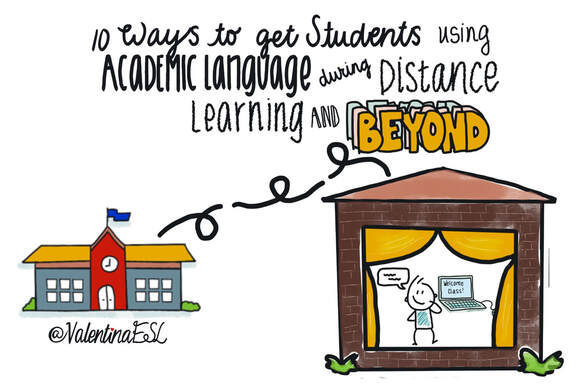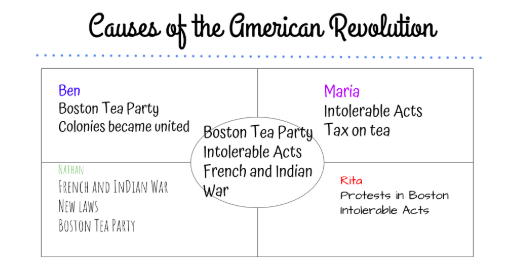|
This article originally posted on Middle Web on 1/6/2019. This is an updated version that includes how to promote academic language during distance learning. “My kids seem to speak English well, but when it comes to academic tasks, they struggle.” We often wonder why English learners have a difficult time with standardized tests and essays in content areas but are able to communicate with peers and get along fairly well on a day to day basis. The reason behind it may be that academic language is different from everyday language. Academic language takes from 5-7 years to acquire while social or conversational language (often known as BICS, basic interpersonal communicative skills coined by Jim Cummins) only takes 2-3 years. What we know is that students need to make greater gains in academic language in order to become successful in school and post secondary. Academic language is the language of the content area of instruction. It is the textbook talk and vocabulary and syntax used in lectures and class presentation. It is not just single words and includes phrases and sentences as well. It is critical that English learners are offered many opportunities on a daily basis to practice using academic language. Why? We have to consider that some English learners go home to environments where they speak another language in the home. And that is awesome! Bilingualism has great benefits. However, to develop bilingualism, when they are in our classrooms or under our instruction, we have to build as many opportunities as possible for English language development using domain specific vocabulary. We have to put the language in their mouths. Other students (including native English speaking students) may go home to English speaking households, but the level of vocabulary or conversation may not be where we’d hope. This is yet another reason why our instruction (be it face to face or remote) needs to be filled with opportunities for students to use academic language. How can we get students to use academic language? Below you will find 10 ways to get students, especially English learners, practicing academic language in your classroom and beyond. These techniques work best with explicit modeling and explanation of the routines. And I caution you that the first time you try one, it might not go as planned. Don’t give up! Just like cooking something for the first time (at least for me), it may not turn out the way you hope, but with practice and repetition, it will improve!
Distance Learning The methods above are easy to implement in a typical classroom. However instituting them into remote teaching and learning involves a bit of creativity. First we have to consider that remote learning looks different from district to district and from virtual classroom to virtual classroom. As I write this in March of 2020, educators across the globe are converting their classrooms and instruction to distance learning because of the Coronavirus Pandemic. Students and teachers are unable to safely hold the same learning space. Therefore, educators are creating learning experiences that require technology and those that do not depending on their district’s, families’, and students’ needs. The instructional techniques below can be implemented using technology such as video platforms, Google Classroom, or LMS (learning management systems). Without technology, the techniques can be adapted into paper-based activities. Think about each through the lens you are working with. Academic language can be challenging for students and for us as educators throw in remote learning and we are truly challenged. Taking a student centered approach where kids are doing the work means a mind shift for many of us. When we create spaces where students negotiate for meaning and they build their knowledge with our support and facilitation greater gains will occur!
9 Comments
Olga I Shmarina
4/16/2020 08:51:46 am
Thank you, Valentina! these are so helpful!
Reply
Concetta Viggiani
5/8/2020 03:02:29 pm
I found this article to be informative and useful. It always goes back to BICS and CALPS. The question is how do we move the students from BICS to CALPS. The activities mentioned sound fun and engaging. At the same time the students are building language skills. The chart that shows how to use during remote learning is something that is definitely worth trying.
Reply
Cindy Britt
8/24/2020 07:02:28 am
Excellent!
Reply
Reham Shehata
9/21/2020 07:27:38 pm
These are excellent strategies. Thank you for adapting them to distance learning. I'll definitely use them in my virtual classroom.
Reply
Marion E Martin
10/20/2020 03:51:03 pm
This was very helpful. I am developing a Weekly Newsletter to help the teachers in our Consortium with distance and hybrid learning. I loved your strategies for encouraging academic conversations during distance learning. Would you send me a link to that that chart?
Reply
Jenna Hafner
11/18/2020 12:36:44 pm
I would love to see an example of a digital interactive word wall. Do you have anything you can share?
Reply
Ms. Hunter
12/31/2020 06:40:13 am
Ms. Gonzalez these are excellent strategies! Thank you for sharing. I look forward to revisiting some of these practices I've used before in-person and adapting them to the remote learning setting.
Reply
Ms atallah
3/9/2021 06:06:54 pm
Many of these ideas are ridiculous with in person learning like a conga line and inner outer circle don’t say it’s for distance learning in the title. No beyond yet. I’m in need of real ideas.
Reply
Your comment will be posted after it is approved.
Leave a Reply. |
Categories
All
|





 RSS Feed
RSS Feed
